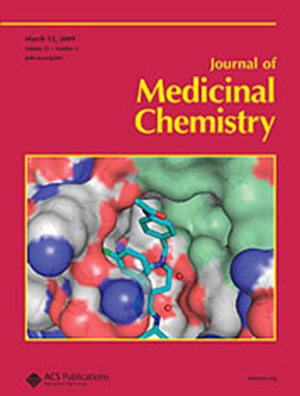基于结构的Hsp90/HDAC6双抑制剂靶向侵袭性前列腺癌的发现
IF 6.8
1区 医学
Q1 CHEMISTRY, MEDICINAL
引用次数: 0
摘要
HDAC6和热休克蛋白90 (Hsp90)是雄激素反应途径中的关键调节因子,表现出密切的相互作用和相互作用模式,使它们的联合抑制成为治疗侵袭性前列腺癌(PC)的有希望的策略。在此,我们提出了基于结构的Hsp90和HDAC6双抑制剂的设计,利用HDAC6的晶体结构要求和两个不同的Hsp90结合袋。该研究发现了化合物17,这是一种有效的、接近平衡的、选择性的HDAC6和Hsp90双重抑制剂,具有良好的药物样特性。该化合物在PC细胞系中表现出良好的抗增殖活性。在三维肿瘤球体模型中,它显示出明显的抗癌活性和靶向肿瘤肿块和肿瘤启动细胞群的能力。此外,联合研究表明,显著的协同效应优于单靶点抑制剂的联合施用。综上所述,化合物17有望用于进一步的临床前评估,以对抗侵袭性PC。本文章由计算机程序翻译,如有差异,请以英文原文为准。
Structure-Based Discovery of Hsp90/HDAC6 Dual Inhibitors Targeting Aggressive Prostate Cancer.
HDAC6 and Heat Shock Protein 90 (Hsp90) are key regulators within the androgen response pathway, exhibiting a close interplay and mutual interaction patterns that make their combined inhibition a promising strategy for treating aggressive prostate cancer (PC). Herein, we present the structure-based design of dual inhibitors of Hsp90 and HDAC6 that leveraged the crystal structure requirements of HDAC6 and two distinct Hsp90 binding pockets. The study led to the discovery of compound 17, a potent, nearly balanced, and selective dual inhibitor of HDAC6 and Hsp90 endowed with favorable drug-like properties. The compound demonstrated excellent antiproliferative activity across PC cell lines. In 3D tumor spheroid models, it demonstrated marked anticancer activity and ability to target both established tumor masses and tumor-initiating cell populations. Furthermore, combination studies showed marked synergistic effects that outperformed the coadministration of single-target inhibitors. Overall, compound 17 stands as a promising candidate for further preclinical evaluation against aggressive forms of PC.
求助全文
通过发布文献求助,成功后即可免费获取论文全文。
去求助
来源期刊

Journal of Medicinal Chemistry
医学-医药化学
CiteScore
4.00
自引率
11.00%
发文量
804
审稿时长
1.9 months
期刊介绍:
The Journal of Medicinal Chemistry is a prestigious biweekly peer-reviewed publication that focuses on the multifaceted field of medicinal chemistry. Since its inception in 1959 as the Journal of Medicinal and Pharmaceutical Chemistry, it has evolved to become a cornerstone in the dissemination of research findings related to the design, synthesis, and development of therapeutic agents.
The Journal of Medicinal Chemistry is recognized for its significant impact in the scientific community, as evidenced by its 2022 impact factor of 7.3. This metric reflects the journal's influence and the importance of its content in shaping the future of drug discovery and development. The journal serves as a vital resource for chemists, pharmacologists, and other researchers interested in the molecular mechanisms of drug action and the optimization of therapeutic compounds.
 求助内容:
求助内容: 应助结果提醒方式:
应助结果提醒方式:


